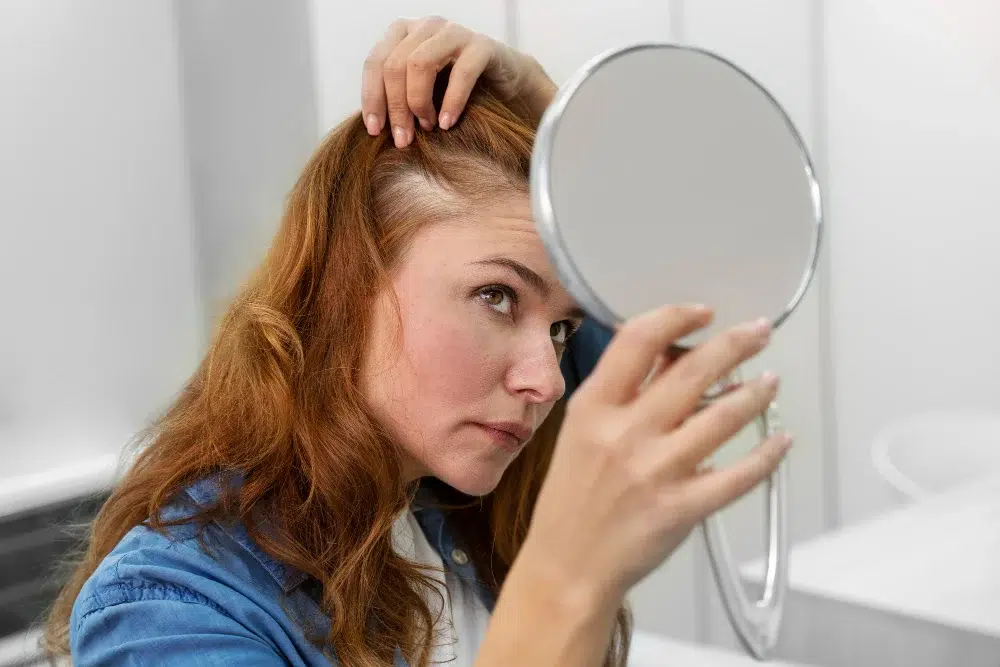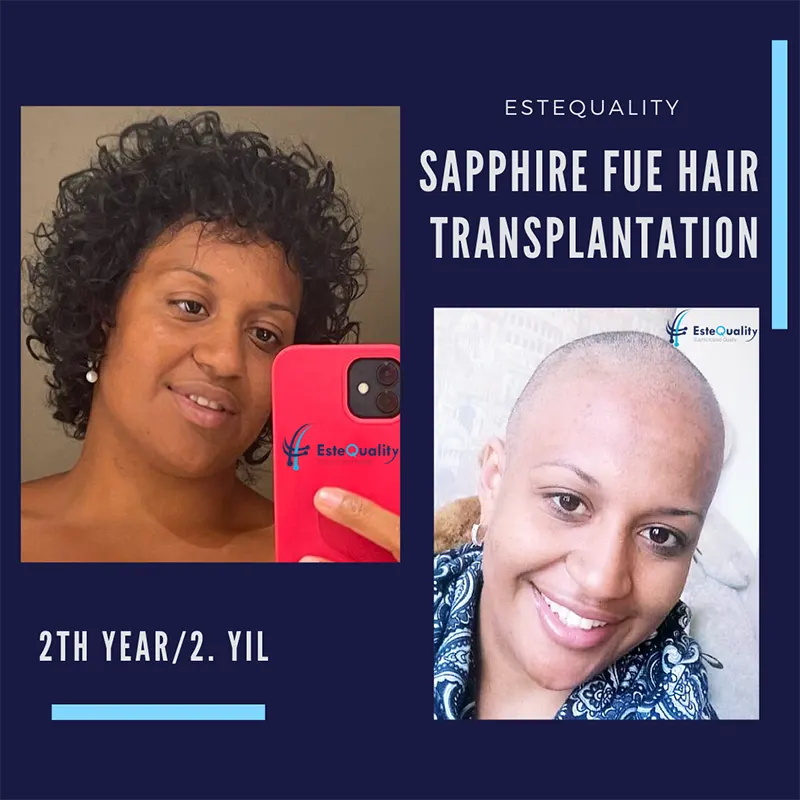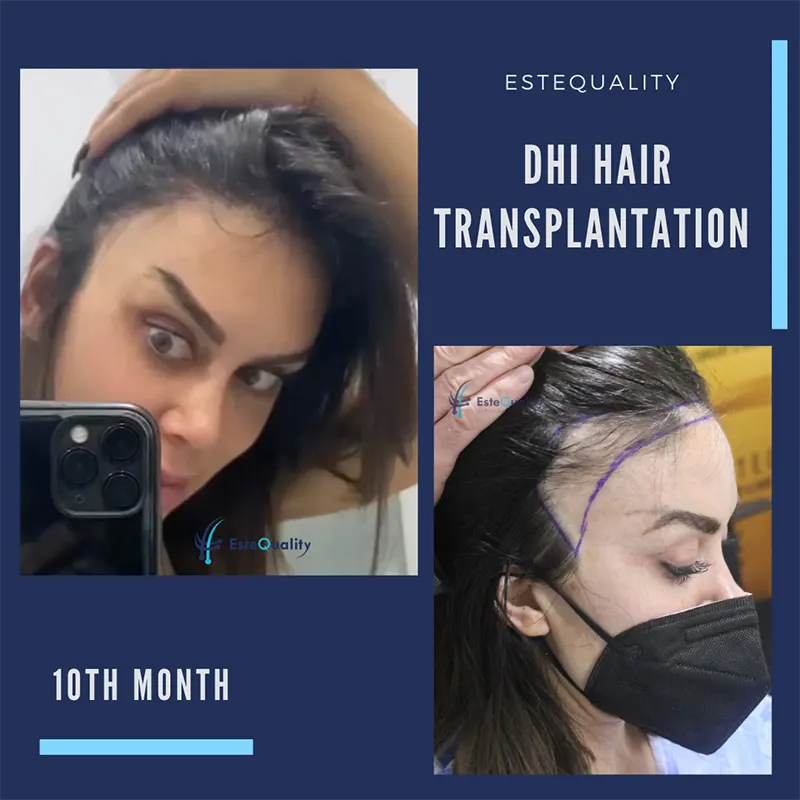TL;DR: Female hair loss is common and can be triggered by genetics, stress, hormonal changes, nutritional deficiencies, medical conditions, or certain hairstyles and medications. Many causes are temporary and respond well to treatment so there’s no need to panic. Modern options range from topical/oral medications and nutritional correction to low-level laser therapy and PRP. For women with stable donor areas, hair transplant surgery can offer a permanent, natural-looking restoration. With the right diagnosis and tailored treatment plan, this problem has a clear solution.
Symptoms of Female Hair Loss
Common symptoms include a widening part or increased scalp show over the crown (typical of female pattern hair loss), reduced ponytail volume, and excess shedding noticed on the brush or in the shower. After major stressors (including childbirth), shedding often spikes several months later and gradually settles as the hair cycle normalizes. Patchy bald spots or eyebrow/eyelash involvement suggest alopecia areata and warrant prompt dermatology review.
Common Symptoms of Female Hair Loss:
- Widening part
- Crown/scalp visibility
- Reduced ponytail volume
- Excess shedding in brush/shower
- Sudden shed 2–3 months after stress/illness
- Patchy round/oval bald spots
- Itching, burning, or scalp tenderness
- Short “baby hairs” that don’t lengthen
Causes of Female Hair Loss
The most common cause is female pattern hair loss (FPHL), a non-scarring thinning that starts at the part/crown. Telogen effluvium (TE) causes diffuse shedding 2–3 months after triggers such as illness, surgery, crash dieting, iron/thyroid problems, medications, or postpartum hormonal shifts. Alopecia areata presents with patchy loss (often with “exclamation-mark” hairs). Traction alopecia results from tight styles and is reversible early but can scar if prolonged. Less commonly, scarring (cicatricial) alopecias cause permanent loss if untreated.
Common Causes of Female Hair Loss:
- Female pattern hair loss (FPHL)
- Telogen effluvium (stress/illness/medications)
- Postpartum telogen effluvium
- Alopecia areata (autoimmune)
- Traction alopecia (tight hairstyles)
- Scarring alopecias (e.g., LPP/FFA)
- Thyroid disorders (hypo/hyper)
- Nutritional deficiencies (iron/ferritin, vitamin D, B12, protein)
- Medications/medical therapies (e.g., retinoids, anticoagulants, chemo)
Female Hair Loss Treatment Options
Effective management depends on cause: FPHL often responds to minoxidil (topical or low-dose oral, off-label) and, in selected non-pregnant women, antiandrogens such as spironolactone; TE is treated by correcting triggers and nutritional deficits; LLLT has supportive evidence for improving density; PRP and microneedling may help some patients; hair transplant is an option only for carefully selected women with stable donor areas. Pregnancy and fertility plans must guide therapy choices.
Female Hair Loss Treatment Options:
- Topical minoxidil
- Hair transplant
- Low-dose oral minoxidil (off-label)
- Spironolactone (non-pregnant candidates)
- Finasteride/dutasteride (selected off-label, specialist oversight)
- Low-Level Laser Therapy (LLLT)
- PRP therapy
- Microneedling / mesotherapy
- Treat triggers: thyroid/iron/vitamin D/protein
- Gentle hair-care & camouflage strategies
FAQ’s About Female Hair Loss
Why am I losing so much hair as a female?
The most common reasons are female pattern hair loss (gradual thinning at the part/crown) and telogen effluvium (a diffuse shed 2–3 months after stress, illness, childbirth, or a major change). Other contributors include thyroid disease, low iron (ferritin), medications, traction from tight styles, and autoimmune alopecia areata. A dermatologist can distinguish these by pattern, exam, and selective tests.
Can female hair loss grow back?
Often—yes, if the cause is temporary (e.g., telogen effluvium typically improves within 3–6 months after the trigger resolves). Alopecia areata may regrow with treatment. Female pattern hair loss is chronic; treatment aims to slow loss and thicken existing hair rather than fully restore it. Scarring alopecias cause permanent loss, so early diagnosis matters.
Which female hormone deficiency causes hair loss?
There isn’t one single “female hormone deficiency.” Hair shedding can follow falling estrogen after childbirth and many women notice pattern thinning around menopause as estrogen declines; thyroid hormone deficiency can also cause diffuse shedding. Evaluation is individualized.
When to worry about female hair loss?
Seek care if you have patchy bald spots, rapid widening of the part, scalp pain/itch/redness (possible scarring alopecia), loss of brows/lashes, or shedding that persists beyond ~3–6 months after a trigger. Post-partum shedding usually settles within a year; if not, get checked.
How much hair loss is too much for a woman?
Shedding 50–100 hairs/day is normal. Consistently more than this—especially with visible thinning—warrants evaluation.
At what age does women’s hair start thinning?
It can begin any time after puberty, but many women first notice it around midlife/menopause; risk rises with age.
Which blood test is required for hair loss in females?
No single test is universally “required.” Clinicians select labs based on history and exam—commonly TSH (thyroid function), ferritin/iron studies, full blood count, and often vitamin D; hormone panels are added if signs of androgen excess are present.
Can too much vitamin D cause female hair loss?
Not typically. Vitamin D toxicity is rare and presents mainly with hypercalcemia (nausea, weakness, confusion). Hair loss is not a hallmark of excess D. Stay within the adult UL of 4,000 IU/day unless your clinician advises otherwise. (Note: excess vitamin A, not D, is well-documented to cause hair loss.)
Ready for Fuller, Healthier Hair?
You don’t have to live with thinning hair. From diagnosis to treatment and women’s hair transplant in Turkey, there’s a clear solution.
- Precision diagnosis & evidence-based care
- PRP, microneedling, LLLT options
- Natural-looking women’s hair transplant





